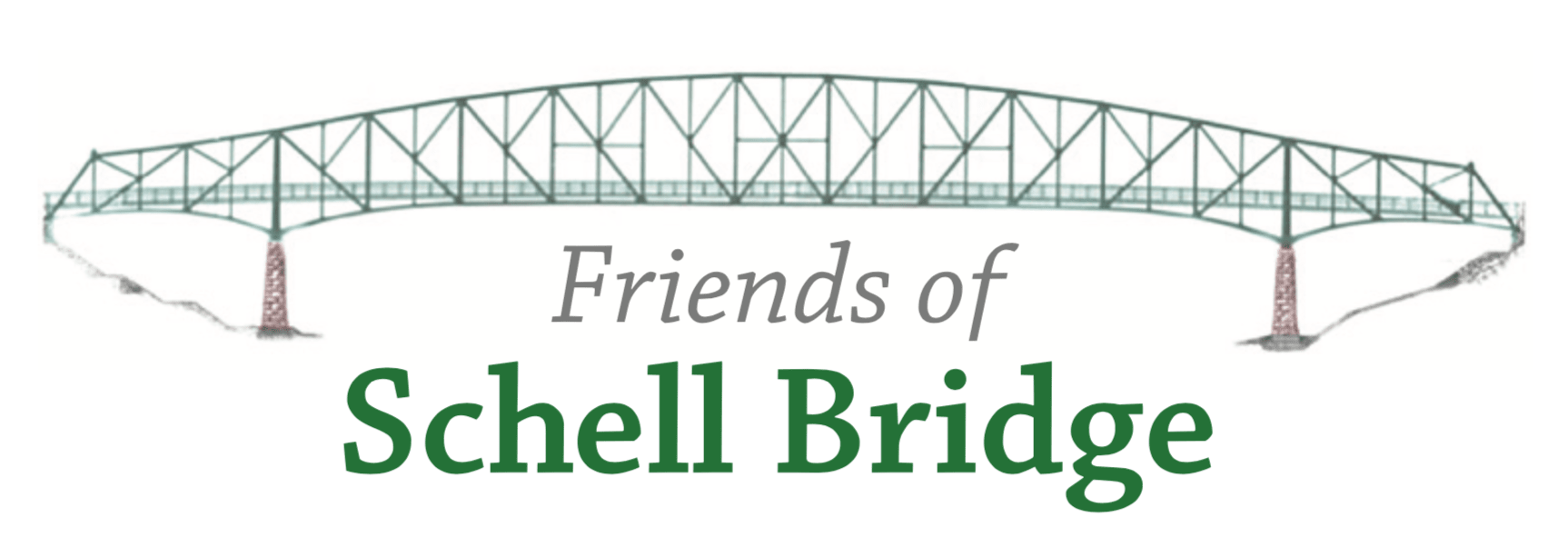FSB Board of DirectorsElected by the membership for three-year terms.
Christine Harris David Kelly Joanne McGeeJon McGowanSusan Ross
OfficersElected annually by the board Kathy Coutu, Chair,Debby Wiesen Kelly, Vice ChairJoanne McGee & Elizabeth Bonney, Secretaries Elizabeth Bonney & Kathy Coutu, Co-Treasurers Board meetings are held on the 4th Thursday of the month.
FSB Bylaws
Christine Harris David Kelly Joanne McGeeJon McGowanSusan Ross
OfficersElected annually by the board Kathy Coutu, Chair,Debby Wiesen Kelly, Vice ChairJoanne McGee & Elizabeth Bonney, Secretaries Elizabeth Bonney & Kathy Coutu, Co-Treasurers Board meetings are held on the 4th Thursday of the month.
FSB Bylaws
About us
In 2004 Friends of Schell Bridge was formed as a private, non-profit, 501(c)3 corporation to advocate the rehabilitation and reopening of Schell Memorial Bridge for recreational and pedestrian use. In 2013 the MA Department of Transportation proposed, instead of demolishing the Schell (as had been the town's plan), replacing it with a new pedestrian/biking bridge incorporating as much of the Schell historical character as feasible. Both Friends of Schell Bridge and the Town of Northfield supported this proposal. The Department of Conservation and Recreation will own and maintain the new bridge.
Our Vision
Friends of Schell Bridge remains dedicated to the goal of a new pedestrian/bike pathway across the CT River and will remain proactive while the town, the Advisoruy Committee, MassDOT, and state representatives develop ways to move forward. Members, near and far, help to keep us engaged, enthusiastic, and committed. Your continuted support is greatly appreciated.
Thank You,
Kathy Coutu, Chair
Strategic Plan
In 2003 Schell Memorial Bridge was named by PreservatiON Mass as one of the ten most endangered historical landmarks in Massachusetts. Galvanized by this honor, in 2004 Friends of Schell Bridge incorporated as a non-profit organization to generate interest in saving the bridge and rehabilitating it for pedestrian and bicycle paths. Friends of Schell Bridge (FSB) contacted the Picker Engineering Program at Smith College for an independent assessment of the condition of the bridge. A senior student design team, working with two professional structural engineers from New York City, evaluated and tested components of the bridge. Their detailed report in 2005 emphasized that the bridge structure, while some components needed to be replaced, was structurally sound and a good candidate for rehabilitation.
In 2006, FSB spent significant energy in building community support. A petition circulated gathered 1400 supporters, including 700 in the small town of Northfield. In 2007, FSB successfully rallied voters to support nominating Schell Bridge, eligible since 1982, for the National Register of Historic Places.
Following an informational meeting with the Massachusetts Highway Department in September 2006, FSB decided to develop a strategic plan to save the bridge as an historic treasure by highlighting the recreational, economic, cultural, and environmental values Schell Bridge offer for the twenty-first century. FSB has contacted Connecticut River conservation groups and has participated in meetings in the region to share information and to enlist assistance and support. The strategic plan represents an effort to share this vision with Northfield citizens, town officials, regional organizations, state and federal elected representatives, and national organizations who might want to become involved.
Click on the image to get a 2 meg PDF file that you can view and print, or request a high-quality printed version at info@schellbridge.org.
In 2006, FSB spent significant energy in building community support. A petition circulated gathered 1400 supporters, including 700 in the small town of Northfield. In 2007, FSB successfully rallied voters to support nominating Schell Bridge, eligible since 1982, for the National Register of Historic Places.
Following an informational meeting with the Massachusetts Highway Department in September 2006, FSB decided to develop a strategic plan to save the bridge as an historic treasure by highlighting the recreational, economic, cultural, and environmental values Schell Bridge offer for the twenty-first century. FSB has contacted Connecticut River conservation groups and has participated in meetings in the region to share information and to enlist assistance and support. The strategic plan represents an effort to share this vision with Northfield citizens, town officials, regional organizations, state and federal elected representatives, and national organizations who might want to become involved.
Click on the image to get a 2 meg PDF file that you can view and print, or request a high-quality printed version at info@schellbridge.org.
Economic Impact
In 2010 an Economic Impact Analysis of rehabilitating Schell Bridge for recreational and pedestrian use was completed. Such a study assesses how the rehabilitation and subsequent visitor spending would benefit the local and regional economies, through increased economic activity such as job creation, additional business activity, and other economic endeavors of various kinds.
The Center for Economic Development at the University of Massachusetts was commissioned in the summer of 2010 to conduct this study, and the final report completed in the spring of 2011. The results indicate a regional (county level) benefit on the order of $6,400,000 due to the construction phase of rehabilitation and a conservatively-estimated $840,000 per year in visitor spending during the first decade after the bridge is reopened.
Click Here to see the complete report.
The Center for Economic Development at the University of Massachusetts was commissioned in the summer of 2010 to conduct this study, and the final report completed in the spring of 2011. The results indicate a regional (county level) benefit on the order of $6,400,000 due to the construction phase of rehabilitation and a conservatively-estimated $840,000 per year in visitor spending during the first decade after the bridge is reopened.
Click Here to see the complete report.
